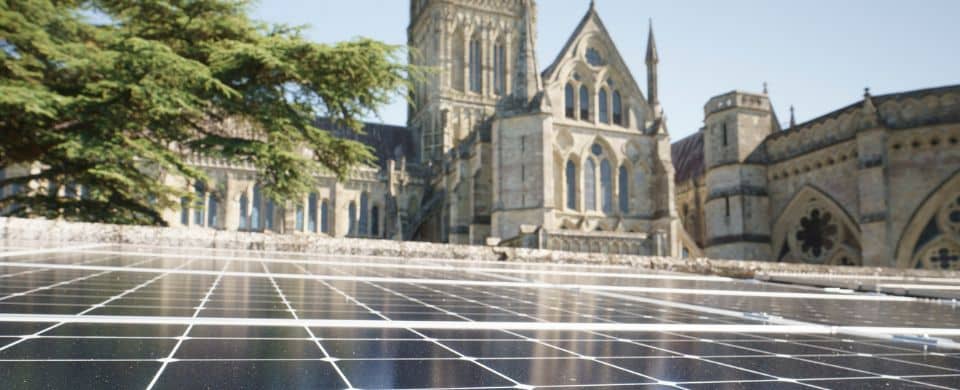The Anglican Route to Net Zero
By Helen Stephens, Head of Church Relations
Earlier this month, the Church of England’s General Synod approved a Routemap to Net Zero by 2030 as proposed by the CoE Environmental Working Group. By mid-July an unprecedented European heatwave, during which UK temperatures exceeded 40 degrees centigrade for the first time, only underscored the urgency of all sectors of society, and government, to act on climate change. The Church’s target and Routemap are ambitious and rightly so – we are, after all, in uncharted territory. The process will be as important as the outcome and it will take more concerted effort than the Church has shown so far.
What is Net Zero and how are they proposing to get there?
The CoE’s definition is the reduction as far as possible of in-scope carbon emissions (i.e. those from the oil, gas and electricity used in buildings, and petrol and diesel used for transport) and the removal of an equivalent amount of carbon from the atmosphere for all remaining in-scope emissions. Essentially, the CoE’s approach will be to reduce direct emissions as far as possible and offset only as a last resort. The plan is to reduce direct carbon emissions year on year in order to have cut 90% of today’s emissions by 2030. This would leave less than 10% of today’s emissions to be offset through verifiable schemes.
The Routemap is a framework for decarbonising actions across the Church of England’s estate – including churches, offices, vicarages and schools – where it believes it has most direct control or significant influence. It doesn’t focus on procurement, construction, land, or climate resilience, and is not intended to cover the biodiversity crisis, though this is in scope for the wider CofE Environment programme.
The inclusion of land is vital in the overall programme. We proposed that it also be in the Routemap and it may be integrated in the future. Significantly, dioceses are asked to review tenancy agreements with farmers on their land, so that they include Net Zero and biodiversity ambitions, to align land management agreements with diocesan environment policy and to develop a management plan for their land (a key criterion for silver Eco Diocese) by 2026.
(See the Routemap appendix for what is in scope after 2030 and that some dioceses may opt to include before then, which A Rocha UK would strongly encourage)
Who is impacted?
The onus for action is very clearly on cathedrals, the largest churches, schools and offices – the Routemap recognises that most small, rural churches have a low carbon footprint. There is plenty for all churches to do though – all are asked to ‘recognise the climate emergency and the General Synod target of 2030’ and ‘make a commitment as a church’ to further action, including measuring the church’s energy footprint.
A Rocha UK welcomes the routemap. This line in the sand is bold, ambitious, and stretching, even more so when the Church is still dealing with the impacts of a pandemic on church attendance and income.
Other denominations are taking up the challenge too. The 2022 Methodist Conference set a target of becoming a net zero emissions Church by 2030 and the Church in Wales voted unanimously to endorse its Net Zero by 2030 Challenge.
The Church needs to translate Net Zero into something meaningful for every member – we all have a part to play in reducing carbon emissions. A Rocha UK’s independent and cross-denominational Eco Church programme can be a powerful tool here and we welcome that recognition by the Church of England: Eco Church is mentioned more than a dozen times in the Routemap.
It is part of every church’s mission to take action to care for the environment. We must develop a holistic vision of a healthy, flourishing, low/zero carbon, sustainable Church.
Sign up to receive future eNews communications here.
To find out more about the Routemap you can join a forthcoming CofE webinar for a Routemap briefing and overview on the following dates:
Tuesday 30 August, 12 noon. Sign up here.
Monday 5 September, 4pm. Sign up here.
Tuesday 6 September, 12 noon. Sign up here.
Image: with thanks to Ash Mills.






Your article doesn’t mention the slow pace of divestment in fossil fuel by the church of England in general
This is very encouraging but I do wonder how efficiently the C of E is communicating this to parishes. We only found out about the Net Zero Carbon target by accident in 2021 when a member of our newly-formed Eco Action group was doing some research and a recent conversation with a friend who is on the PCC of another local church showed that they had never heard about the 2020 General Synod resolution. It may be that the info sent by the diocese has been put to one side as churches face many challenges as a result of the pandemic but it would be great to see it given a higher profile!
Hello,
I am really looking forward to the Routemap briefing. We have returned our church’s energy footprint and nearly completed the 360 tool.
However I am very concerned about our energy supply – Parish Basket sourced from TotalEnergies, which allows us to state that all our energy is renewable. Really? . After driving through France I am in no doubt that TotalEnergies sells petrol! What is more it is investing in further fossil fuel extraction. It is unclear to me how it is providing sufficient renewables to meet it’s green tariff, and I suspect there is much greenwashing and use of unreliable offsets. Carbon offsetting is wholly unsatisfactory as a means of reducing CO2 production – assurance is weak to non-existent in many of the supposed sites. As I write there are forests burning down in the US which have been allocated 100 year carbon offsets to BP amongst others. Surely it is time for the Church to find an alternative supplier with more robust green credentials: Octopus, Ecotricity, Good Energy. They may not be the very cheapest, but perhaps they are more truthful than TotalEnergies. Meanwhile what we must all do is use less if we are to make a difference.